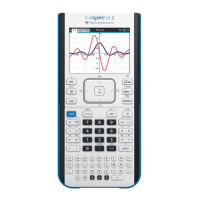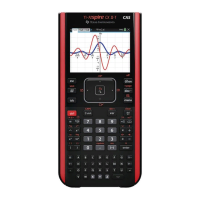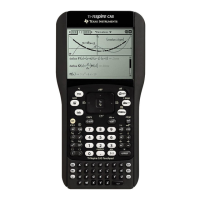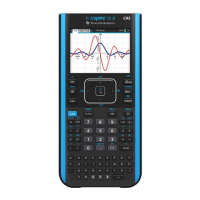18 TI-Nspire™ Reference Guide
completeSquare()
Catalog
>
completeSquare(ExprOrEqn, Var ) ⇒ expression or equation
completeSquare(ExprOrEqn, Var ^P ow e r)
⇒ expression or
equation
completeSquare(ExprOrEqn, Var1, Var2 [,...])
⇒ expression or
equation
completeSquare(ExprOrEqn, {Var1, Var2 [,...]})
⇒ expression
or equation
Converts a quadratic polynomial expression of the form a·x
2
+b·x+c
into the form a·(x-h)
2
+k
- or -
Converts a quadratic equation of the form a·x
2
+b·x+c=d into the
form a·(x-h)
2
=k
The first argument must be a quadratic expression or equation in
standard form with respect to the second argument.
The Second argument must be a single univariate term or a single
univariate term raised to a rational power, for example x, y
2
,orz
(1/3)
.
The third and fourth syntax attempt to complete the square with
respect to variables Va r 1, Va r 2 [,… ]).
conj()
Catalog
>
conj(Va lu e 1) ⇒ value
conj(List1) ⇒ list
conj(Matrix1) ⇒ matrix
Returns the complex conjugate of the argument.
constructMat()
Catalog
>
constructMat(Expr,Va r1 ,Var 2,numRows,numCols)
⇒ matrix
Returns a matrix based on the arguments.
Expr is an expression in variables Va r1 and Var 2. Elements in the
resulting matrix are formed by evaluating Expr for each incremented
value of Va r1 and Va r2 .
Va r1 is automatically incremented from 1 through numRows. Within
each row, Va r 2 is incremented from 1 through numCols.
CopyVar
Catalog
>
CopyVar Va r1 , Va r2
CopyVar Va r1 ., Va r 2.
CopyVar Va r 1, Va r2 copies the value of variable Va r1 to variable
Va r2 , creating Va r 2 if necessary. Variable Va r 1 must have a value.
If Va r1 is the name of an existing user-defined function, copies the
definition of that function to function Va r2 . Function Va r 1 must be
defined.
Va r1 must meet the variable-naming requirements or must be an
indirection expression that simplifies to a variable name meeting the
requirements.

